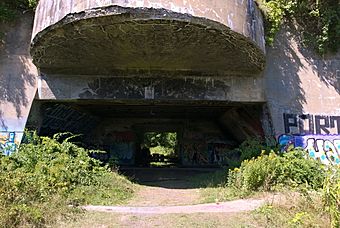Battery Steele facts for kids
Quick facts for kids Battery Steele |
|
|---|---|
| Part of Harbor Defenses of Portland | |
| Peaks Island, Maine | |
| Type | Fortification |
| Site information | |
| Open to the public |
Unknown |
|
Battery Steele
|
|

Battery Steele on Peaks Island, Portland, Maine
|
|
| Location | Peaks Island, Portland, Maine |
| Built | 1942 |
| Architect | U.S. Army Corps of Engineers |
| NRHP reference No. | 82000745 |
| Added to NRHP | October 20, 2005 |
| Site history | |
| Built | 1942–1945 |
| Built by | U.S. Army Corps of Engineers |
| In use | 1942–1945 |
| Materials | Reinforced concrete, earth |
| Battles/wars | World War II |
| Garrison information | |
| Garrison | Harbor Defenses of Portland |
Battery Steele is a large military fort on Peaks Island, near Portland, Maine. It was built during World War II and finished in 1942. This fort is located on 14 acres of land on the island's ocean side. It was once part of the Peaks Island Military Reservation.
The battery is named after Harry L. Steele. He was an officer in the United States Army Coast Artillery Corps during World War I. Battery Steele had two very powerful 16-inch guns. These guns, along with others at Fort Levett, replaced older, less powerful guns. Their job was to protect Casco Bay and especially Portland harbor. This area stretched from Kennebunk to Popham Beach.
Experts say that Battery Steele is the biggest gun battery ever built in the United States. After many years of not being used, a group called the Peaks Island Land Preserve bought the area in 1995. They wanted to keep it as a public space forever. In 2005, Battery Steele was added to the National Register of Historic Places. Other old military structures on the island include lookout towers and parts of old searchlight towers.
Why Was Battery Steele Built?
Battery Steele was part of a big plan started in 1940. This plan aimed to replace old coastal defenses. Many of these older forts were built between 1885 and 1905. In the Harbor Defenses of Portland, only one large gun battery was still used by 1944. This was Battery Foote at Fort Levett. It had two 12-inch guns and was protected from air attacks.
Another 16-inch gun battery was planned near Two Lights State Park. However, this plan was canceled. By 1943, there was very little threat from enemy ships on the US East Coast.
Other Batteries in Casco Bay
During World War II, smaller batteries were also built. Three batteries with 6-inch guns were constructed in Casco Bay. Only one of these, Battery Cravens on Peaks Island, was actually used. Today, it is part of a private home.
Older 6-inch gun batteries were still used at Fort McKinley and Fort Levett. Three older 3-inch gun batteries were kept at Fort Williams, Fort Preble, and Fort Lyon.
Three new 3-inch gun batteries were built during the war. These were on Peaks Island, Long Island, and Great Chebeague Island.
Anti-Motor Torpedo Boat Batteries
Many Anti-Motor Torpedo Boat (AMTB) batteries were also built. These batteries had 90 mm guns. Each battery was supposed to have four 90 mm guns. Two guns were fixed in place, and two could be moved. These guns could shoot at both enemy planes and ships.
These AMTB batteries were located in several places. They were on Long Island, Great Chebeague Island, Bailey Island, Peaks Island, Jewell Island, Fort Levett, and Fort Williams.
Soon after World War II ended, all US coastal defenses were closed. Most of the guns were taken apart and sold for scrap metal.



